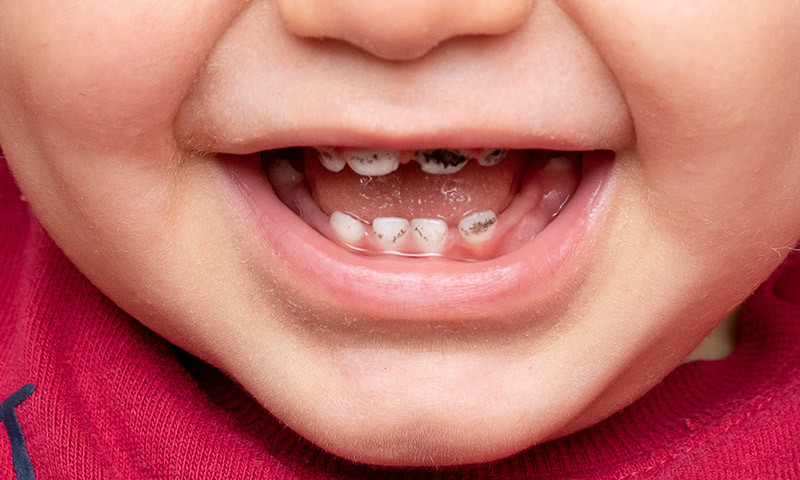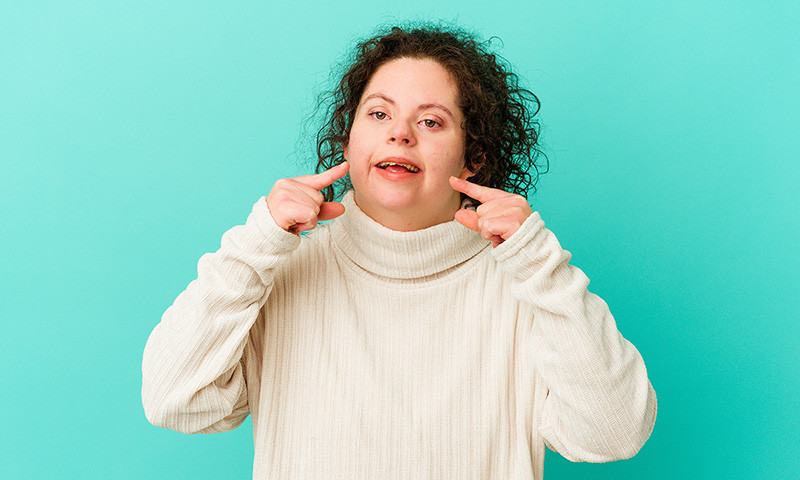Definition: What is fluorosis?
Fluorosis occurs when the teeth constantly receive too much fluoride over a long period of time. This is especially true for children between the ages of two and six, when tooth formation is not yet complete. The excess fluoride interferes with the formation of the tooth enamel: In mild cases of fluorosis, small white spots appear on the teeth; in severe cases, brown discolouration or even hole-like depressions appear in the tooth enamel.
Generally, fluorosis is considered harmless and merely an aesthetic problem. However, when fluorosis has affected the enamel so much that it becomes porous, it can no longer do its actual job - protecting against caries and other harmful influences - properly. The dentin, which lies beneath the enamel, is then more exposed to bacterial attack.
Acute and chronic fluorosis
Doctors distinguish between acute and chronic fluorosis. In acute fluorosis, there is a short-term excess of fluoride, a fluoride poisoning. This can happen, for example, if a child has eaten a whole tube of toothpaste and gets a stomach ache. However, this article is mainly about chronic fluorosis, which occurs when people take in too much fluoride over a long period of time. Here, a further distinction is made between dental fluorosis and bone fluorosis.
How to recognise acute fluorosis
Signs of acute fluorosis are common symptoms of poisoning. Within a few minutes or hours, vomiting, diarrhoea or constipation, abdominal pain, nausea, paleness and drowsiness may occur. According to the German Federal Institute for Risk Assessment, however, your child has to eat a whole tube of children's toothpaste to get a stomach ache.
To avoid this, it is better not to give your child free access to toothpaste with fluoride and to keep the toothpaste in a place that your child cannot reach unsupervised - for example, in the mirror cabinet above the sink. By the way, adults have to eat two to three tubes of toothpaste to get the first symptoms of poisoning.
Good to know: How to recognise acute fluorosis (fluoride poisoning)
Signs of acute fluorosis are common symptoms of poisoning. Within a few minutes or hours, vomiting, diarrhoea or constipation, abdominal pain, nausea, paleness and drowsiness may occur. However, according to the German Federal Institute for Risk Assessment, your child has to eat a whole tube of children's toothpaste to get a stomach ache. To avoid this, it is better not to give your child free access to toothpaste with fluoride and to keep the toothpaste in a place that your child cannot reach unsupervised - for example, in the mirror cabinet above the sink. By the way, adults have to eat two to three tubes of toothpaste to get the first symptoms of poisoning.
Dental fluorosis and bone fluorosis
Dental fluorosis causes the white or brownish spots on the teeth already described. Bone fluorosis, on the other hand, occurs mainly when drinking water that has been too highly fluoridated over many years. It can lead to stiffening of joints and bones and thus to limited mobility. In the further course of this article, we always mean chronic dental fluorosis by "fluorosis", because this is particularly common in our latitudes.
Good to know:
In Germany, Austria and Switzerland, drinking water is not fluoridated and therefore there is no risk of bone fluorosis. In the USA and other countries where drinking water is enriched with fluoride, the use of a water filter can be useful to prevent fluorosis. This is especially true in regions where fluoride intake is not subject to strict controls and can vary widely - for example, in parts of North Africa, Asia or Latin America.
How common is fluorosis?
It is estimated that about a quarter of the world's population has fluorosis - in varying degrees. Both children and adults are affected. Fluorosis is usually caused by an overdose of fluoride in childhood or by the consumption of drinking water containing fluoride.
Symptoms of fluorosis
The symptoms depend on the severity of the fluoride overdose. The manifestation of fluorosis ranges from fine white lines to holes in the enamel. Often there are white spots over a wide area. Incisors are more frequently affected than molars. Brownish stains are rarer in Europe and are more common in regions with highly fluoridated drinking water - for example in North Africa.
Fluorosis can occur in both milk teeth and permanent teeth. If a child receives too much fluoride during the development of the permanent teeth, the teeth may already erupt with a whitish discolouration. The enamel is still intact at eruption, but can be quickly worn away by brittleness and porosity in the case of severe fluorosis. This can also lead to chipping of the enamel. Discolouration caused by childhood fluorosis will persist into adulthood if not treated.
Influence on psyche and behaviour
The white spots may not be dangerous and do not cause pain. Nevertheless, many of those affected suffer greatly from them. They are ashamed of the appearance and try to hide the spots by, for example, only laughing or talking behind their hands. In children, it can also lead to exclusion and bullying.
Fluorosis or caries?
White spots on the teeth are not necessarily a sign of fluorosis. So-called white spots can also indicate caries in the early stages. A dentist can easily distinguish between the two symptoms: While the white spots of fluorosis spread over a large area of the tooth, the smaller, defined white spots are mainly found in places where plaque easily forms - for example, on the necks of the teeth and around braces .
Instructions: Clean fixed braces properly
Here you can see the difference between white spots caused by caries and fluorosis by looking at pictures:
Good to know:
White spots on the teeth can have other causes: Antibiotic treatments during pregnancy or in infancy, injuries to the milk teeth or even hereditary predisposition. In about ten percent of patients, parents and children have the same white spots on the same tooth in the same position. Whitish to brownish discolouration also occurs in chalk teeth .
Cause: Where does fluorosis come from?
Fluorosis occurs when there is too much fluoride in the body. The principle of "less is more" applies to fluoride. The natural active ingredient occurs naturally in our bones and teeth and has also been proven to be an effective caries protector, which has ensured that dental disease has declined sharply in recent decades. However, we must not overdo it with fluoride intake. Fluorosis occurs when the intake of different fluoride preparations is combined in an unfavourable way. You can find out exactly what the recommended intake is in the prophylaxis section.
We can ingest fluoride in the following ways:
- Fluoride in water
- Fluoridated salt
- Toothpaste with fluoride
- Fluoride tablets
- Natural occurrence of fluoride in foods
Fluorosis in babies and children
There is no clear consensus in the medical world on which way babies and children should take fluoride: in the form of fluoride tablets or as toothpaste? In the meantime, studies have shown that fluoride is better absorbed by the teeth when it has direct contact with the tooth surface, which should make toothpaste the fluoride source of choice. This is why dentists recommend the use of fluoridated toothpaste for children. However, some paediatricians continue to use fluoride tablets. If parents mean well for their children and give them fluoride tablets and brush their teeth with fluoride toothpaste, it is simply too much of a good thing. Fluorosis is then pre-programmed.
According to the German Nutrition Society, if the upper limit of 0.1 milligrams of fluoride per kilogram of body weight is exceeded for a long time, one can expect fluorosis to occur - especially between the ages of two and eight.
Fluorosis due to toothpaste?
You may be wondering whether you should take the precaution of not using fluoride toothpaste to prevent your child from developing fluorosis. You are not alone in asking this question. And many people have come to an answer - albeit the wrong one:
Especially in internet forums and alternative health blogs, fluoride is often torn apart and portrayed as harmful to health. As a result of this opinion mongering, more and more people are having doubts about whether they should use a fluoride toothpaste at all.
Doctors, health authorities and scientists all agree that fluoride effectively protects against tooth decay and is safe as long as you do not consume it in tubes, but brush your teeth with it in the normal way.
If you follow the official recommendations (see prophylaxis section) and do not give your child fluoride tablets at the same time or live in a region with highly fluoridated drinking water, you do not have to worry about possible fluorosis. Read more about this topic in our article:
Fluorosis in adults
In adults, too, an overdose of fluoride in childhood is the most common cause of fluorosis in German-speaking countries. In other parts of the world, adults can get fluorosis from consuming drinking water that is too heavily fluoridated.
Fluorosis stains after bleaching?
Some people experience a nasty surprise after a bleaching : instead of a radiant white smile, they discover white spots when they look in the mirror. The bleaching itself has not caused any fluorosis, but has optically intensified already existing spots. These spots may have been caused by fluorosis, but there may also be another reason.
So why does bleaching cause fluorosis to appear? During bleaching, the dentist applies a bleaching agent with hydrogen peroxide to the tooth enamel surface, which removes protective minerals from the tooth enamel . If the enamel is already weakened, the bleaching agent has an even stronger effect - and thus these spots become even brighter. The white spots after bleaching usually disappear after two to three days, when the enamel has regenerated. In exceptional cases, however, they can remain.
Diagnosis
If you notice white spots on your child's teeth, you should make an appointment with the dentist to see if it is fluorosis. During the examination, the dentist will determine how severe the fluorosis is. The scale ranges from one - limited discolouration - to eight - limited and extensive discolouration with changes in tooth structure. In addition, your dentist will talk to you to determine the reason for the increased fluoride intake so that the overdose can be stopped and the fluorosis will not get worse.
The dentist will now also determine whether it is a purely aesthetic problem or whether the enamel is already affected and thus the risk of caries is increased.
Treatment: How to remove the stains in fluorosis?
If the fluorosis has not yet attacked the enamel, but it is only an optical discolouration, the white spots are not a danger to dental health and can actually be ignored. Especially in children, the aesthetic treatment of fluorosis is not recommended as long as it is only an optical problem.
However, since many people suffer psychologically from the appearance of fluorosis, we show possible treatment measures here.
Will fluorosis go away?
First of all, some bitter news: fluorosis doesn't just go away on its own and you can't just remove the stains either. This requires dental treatments, some of which are only suitable for adults. Therefore, it is especially important that you pay attention to the correct fluoride dosage for your child.
Stop the fluoride supply
If your dentist has confirmed that fluorosis is indeed present, the fluoride intake should first be stopped so that the fluorosis does not worsen.
The following measures may be appropriate:
- Stop taking fluoride tablets
- Drink water without fluoride or with low fluoride content
- Use non-fluoridated salt
- It is best to discuss which specific measures are suitable in your situation with your dentist.
Which toothpaste for fluorosis?
There is no toothpaste that actively works against fluorosis. However, since fluorosis is caused by an excess of fluoride in the body, it is advisable to switch to a fluoride-free toothpaste, at least temporarily, to avoid adding extra fluoride to the body.
Treatment at the dentist
If you want to have fluorosis stains removed because they bother you visually, or if the fluorosis has already progressed to the point where the enamel is damaged, treatment by a dentist is necessary.
Caries infiltration and bleaching
A combination of caries infiltration and whitening is often used in the treatment of fluorosis. In caries infiltration, the dentist treats the enamel with an acidic gel so that the enamel opens up and a highly fluid resin called ICON can penetrate the cavities. This restores the tooth structure and seals the enamel. This method is also suitable for advanced fluorosis.
With bleaching, the rest of the tooth can be whitened so that the contrast with the white spots is less. Brown stains can also be made whiter by bleaching.
Good to know:
Bleaching is not suitable for everyone: Children and adolescents under the age of 18, pregnant and breastfeeding women and patients with caries should not have their teeth whitened. In addition, the gums must be healthy - without inflammation or swelling.
Composite fillings
A composite filling can be used when the tooth enamel is damaged. Holes are filled with a tooth-coloured filling material to reconstruct the tooth.
Veneers
Veneers are very thin ceramic shells that are bonded to the tooth with a special adhesive. The underlying fluorosis is masked, so to speak, and the white spots disappear behind the façade of the veneers. Disadvantage: The costs of the treatment are high and - since it is an aesthetic intervention - are usually not covered by health insurance. In addition, the teeth are damaged in the process: In order for the veneers to adhere properly to the teeth, they must first be ground down. This permanently damages the tooth substance. This method is only recommended if the stains are very severe and cause great psychological suffering.
Are there any home remedies to remove the stains from fluorosis?
Unfortunately, there is no cure for fluorosis. Or maybe there is? According to scientific studies, the herb tulsi - also known as Indian basil - can remove fluoride from water and thus protect people in India from fluorosis caused by drinking water that is too heavily fluoridated. Whether this home remedy also helps against the white spots on the teeth has not yet been clarified.
However, you should stay away from homemade dental care products that are advertised on alternative beauty blogs. Baking soda, baking powder, salt and pure activated charcoal powder may have a whitening effect at first. However, they will damage your tooth enamel, which is not particularly beneficial, especially if your tooth enamel is already porous due to fluorosis.
Prophylaxis: How to prevent fluorosis
The best way to prevent fluorosis in your child or baby is to follow official recommendations on fluoride dosing so that there is no excess fluoride in the first place.
Dosing fluoride correctly
This table shows which fluoride concentration is suitable for which age to prevent fluorosis. These recommendations are based on the revised guidelines of the European Academy of Paediatric Dentistry (EAPD). Important: The information provided assumes that no fluoride tablets are taken at the same time. If you brush your baby's or child's teeth with fluoride toothpaste, you should never give them fluoride tablets in addition.
Regular check-ups
If you take your child to the dentist regularly, the onset of fluorosis can be detected quickly and further deterioration can be stopped. Even better, your dentist can advise you on the use of fluoridated toothpaste and other fluoride sources to prevent fluorosis altogether.
Sources
Aulestia, Francisco et al.: Fluoride exposure alters Ca2+ signalling and mitochondrial function in enamel cells, in: Science Signaling. 2020.
Federal Institute for Risk Assessment: Risk of poisoning accidents in children.
Bundeszentrale für gesundheitliche Aufklärung: Was ist eigentlich eine Fluorose?, auf: kindergesundheit-info.de.
Dentalmagazin: Treat fluorosis stains on the teeth.
Dentlounge: Dental fluorosis: symptoms, causes & treatment.
Deutsche Gesellschaft für Ernährung e.V.: Referenzwert Fluorid.
Kropp, Dirk: Fluorosis: white spots on the teeth, on: prodente.de.
Lanza, Florian: Fluorosis, on: mooci.org
Maheshwari, Raaz et al.: Usage of Holy Basil for Various Aspects, in: Bulletin of Environment, Pharmacology and Life Science. 2012.
Meyer-Lückel, Hendrik: Effects of fluoride tablets on caries and fluorosis occurrence among 6- to 9-year olds using fluoridated salt, in: Community Dentistry and Oral Epidemiology. 2010.
Meyer-Lückel, Hendrik: Ten years of caries infiltration: Successful in caries and also in fluorosis, on: zm-online.de
Schaffner, Markus et al: Dental fluorosis, in: Swiss Dental Journal. 2015.
Steinert, Jürgen et al.: Macht uns Fluorid in Zahnpasta krank?, on: oekotest.de.
Stiftung Warentest: What you need for healthy teeth.
Stiftung Warentest: Are fluoride, zinc and titanium dioxide dangerous?...
Thumeyer, Andrea: Prävention und noninvasive Therapie von (Initial-)Karies - eine besondere Herausforderung bei Kindern unter drei Jahren, on: zmk-aktuell.de.
Toumba, K.J. et al: Guidelines on the use of fuoride for caries prevention in children: an updated EAPD policy document, in: European Archives of Paediatric Dentistry. 2019.
All websites last accessed on 12.06.2023.
 Swiss premium oral care
Swiss premium oral care










